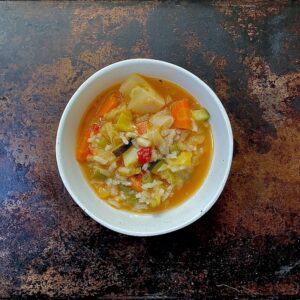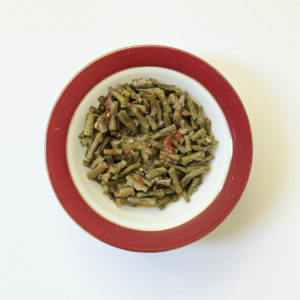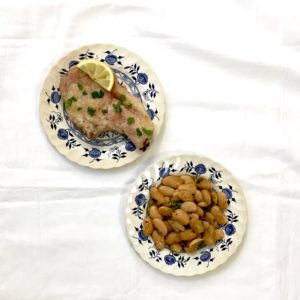Ribollita
Ribollita, Italy’s soup of water, beans, greens, and bread, is one of the country’s many ingenious methods of using up stale bread. The inspiration for today’s post comes from Carol Field’s classic The Italian Baker.

—
Before going any further, the obvious must be stated: I am not Italian. I have never visited Italy. Travel with a wheelchair user is extremely difficult. It is also prohibitively expensive.
Meaning today’s recipe post is not at all authentic. How could it be?
My cookbooks offer numerous bean and green soups, many of them Italian, Italianate, or at least Mediterranean. Are they ribolllita? No, not exactly. But does it exactly matter? This depends on who you ask. Some people are very concerned about provenance and authenticity and fret over some group being exploited. Never mind the group in question is vaguely defined and soup in question is prepared, in some version or other, across the Mediterranean continent.
We might also turn the notions of appropriation and exploitation–only in this instance–on their heads, noting the cooking of these recipes indicates admiration for the cultures and recipes in question, not ill will. Broadly speaking, people cook and eat dishes from other cultures because they’re interested in trying something new. The impulse to try a recipe springs from goodhearted interest and, of course, appetite. This is not appropriation. It is appreciation.
Back to ribollita.

—
Ultimately, the above may be making too much of a simple way to finish a staling loaf in chilly weather, which a good portion of the United States is experiencing just now.

—
Into the kitchen.
Ribollita is not difficult to prepare, but be warned: the ingredient list is long. The prep is what the English call a faff: much washing, cutting, trimming, and chopping. There are cooks who find such work restful, others who detest it, and those whose mood is dictacted by circumstance (especially now, so soon after the holidays).

Wherever you fall, should your kitchen be like mine where prep space is concerned–that is, lacking, take especial care. Now is not the time to be sloppy about mise en place. Make sure your prep spaces are clear, your knives sharp, and your biggest soup pot down from the high shelf (ahem.)

Greens can be extremely gritty. I wash mine by placing them in my largest bowl, filling it with cool water, and swishing the leaves about repeatedly. I then roll the leaves tightly in a clean dishtowel.

Liberties I took with the recipe:
I had cooked cannellini beans in the freezer, and used them in the soup.

I used home-canned tomatoes instead of fresh.

Some versions of ribollita call for pancetta. I used a smoked turkey leg, which is completely inauthentic. In my defense, my spouse is still extremely underweight from his medical emergency last year, and he loves smoked turkey. Any port in a storm. As smoked turkey leg is not especially photogenic, I give you celery, which is far prettier.

Paula Wolfert gives a ribollita recipe calling for a Parmesan rind. As I have a Parmesan cheese in the fridge, I cut part of the rind off and dropped it into the soup. See above concerning skinny spouse. Lacking a photo of the parm rind, I give you alliums and a parsnip. which ultimately didn’t make it into the soup.

—
Once all the veg, beans, and greens are in the pot, it is simply a matter of leaving the ribollita to itself. Further, because this soup is water rather than broth-based, it benefits from being prepared ahead of time. In fact, it should be: ribollita means “reboiled”; i.e. reheated. This is a dish that only improves with hanging around.

It is best to use dried beans when making ribollita. If this is simply too much of a much, buy the best canned beans you can afford. If you can find Italian beans in glass jars, go for it.

Field’s recipe calls for dark Tuscan bread or the Italy’s famous saltless bread, Pane Toscano. Her recipe advises readers to grill, toast, or saute bread just before serving. Brush each slice with olive oil, place it in the bottom of each diner’s bowl, and pour the soup over.

Finally, a word about amounts. There is no way to make a teensy amount of ribollita, but as noted above, it holds well. If you find you and yours cannot bear another night of it, freeze it.

Ribollita is a meal in itself. All you need at the table is a sturdy red wine and a bottle of your best olive oil. Carol Field writes that Tuscans do not include cheese in their Ribollita, but Paula Wolfert gives a recipe for Sienese Ribollita in Mediterranean Clay Pot Cooking that does include Parmesan. So do as you wish, as an informed eater of this marvelous example of Italian cuisine.

Ribollita
Italian Bean, Green, and Bread Soup
Adapted from recipes in The Italian Baker, by Carol Field, and Mediterranean Clay Pot Cooking, by Paula Wolfert
Note: the only fixed ingredients in Ribollita are beans, stale bread, and Cavolo Nero Kale. The rest is a question of season, locale, and personal taste. If you cannot get Cavolo Nero Kale, substitute another bunch of dark leafy greens.
Yield: It is hard to quantify soup. The amounts given generously feed six.
Prep time: as noted in the post, Ribollita is not difficult to prepare. It requires a great deal of prep: washing, trimming, chopping, and slicing. Allow yourself at least 45 minutes. Clear a working space and sharpen your knives. Once the ingredients are in the pot, your work is done.
Please see notes, below for further discussion of ingredients.
You will need an 8 quart/liter soup pot or comparably sized vessel to prepare Ribollita.
olive oil, for the soup pot
1/2-1 cup/125-250 grams dried cannellini or pinto beans
1 bunch/8 ounces/227 grams Cavolo Nero Kale or other dark leafy greens
1 bunch/8 ounches/227 grams Collard or other dark leafy greens
1 yellow onion, peeled and chopped
1-2 carrots, peeled and sliced into thin coins
2 large garlic cloves, peeled and minced
1-2 sticks celery, washed, trimmed and sliced into thin coins
large thyme sprig
a few sprigs parsley
1 tablespoon tomato paste
2-3 large tomatoes, seeded and chopped, or one 12-ounce/340ml can organic whole tomatoes in juice,
1 large Russet potato, peeled and cubed
salt and pepper
6-8 cups water
Good quality stale bread: I used an Acme Sour Batard
Your best olive oil, for serving
Optional:
Parmesan cheese rind
pancetta
smoked turkey leg (totally inauthentic, but I added one)
a smattering of red pepper flakes
If you are using dried beans, soak them. Instructions always say overnight, but the beans I buy are fresh enough to require only 2-3 hours soaking time. Given they’re being used in soup–meaning they will be soaking even longer, use your judgement and soak accordingly.
Greens can be extremely dirty. I wash by placing them in a giant bowl, filling it with cool water, and swishing the leaves about. I drain and repeat until the water is clear, then roll the leaves tightly in a clean dishtowel.
I then tear, cut, and shred greens from their stems, tossing them into the same (cleaned) bowl I used to wash them. I use scissors, my hands, and a sharp chef’s knife.
Once you’ve prepped all the vegetables, heat a generous 1/4 cup/60 ml olive oil over medium heat in the soup pot. Add the onion, carrot, garlic, celery, thyme, and parsley. Let the aromatics cook gently, without taking color, for about ten minutes. Stir occasionally. If the vegetables start browning, turn the heat down.
Add the tomato paste, tomatoes or canned tomatoes, beans, greens, and potato cubes. Turn the vegetables and greens around in the oil to saturate them. Saute for a few minutes, then add water to just cover.
Season with salt and pepper. Add parmesan rind, if using. Add pancetta, turkey, and red pepper flakes, if using.
Bring ribollita to a gentle boil, then turn down to a simmer and allow soup to cook for at least two hours, stirring occasionally.
Check for salt, tasting as the soup cooks.
If you are using a smoked turkey leg, check after two hours: it should be tender enough to shred. Remove the leg to a plate or bowl and allow to cool. Shred meat into the soup. Return bone to soup or discard; up to you.
The ribollita may be simmered another hour or two and served immediately, but it’s best to simmer it another hour, then allow it to cool completely and refrigerate it, either in its pot, if the pot may be refrigerated, or transferred to a refrigerator safe container, and held up to five days. Reheat–reboil–the ribollita when desired.
When ready to serve, slice the stale bread and either lightly toast–in toaster, under a broiler, whatever method suits–or simply serve as is. You can rub the bread with a freshly cut garlic slice, and dribble olive oil over it, or leave it as is. Place bread at the bottom of wide soup bowls and pour ribollita over. Serve with additional olive oil at the table, for diners to add as wished.
Ribollita keeps well, refrigerated, up to six days. It improves with keeping. It also freezes well.
Notes:
As noted in the post, you can use canned beans, but they do not work as well here: prepare for mushiness.
Traditional Ribollita recipes call for mashing or blending some of the beans and leaving the remainder whole in the soup. This gives a pleasant texture, and you can do this. After all the prep, my tendinitis was expressingly itself quite loudly, and that was that. Should you have similar issues, try mashing beans against the side of the soup pot, or using a potato masher directly in the soup, which is horribly untraditional. My sincere apologies to Italian cooks everywhere. I hope you can forgive me.
For soup-making purposes, all measures are approximate. Only you know how many people you’re feeding and what their appetites are like. Greens are sold in 8-ounce bunches here in the United States (227 Grams), and this recipe reflects that. Feel free to use more, less, or substitute what is available in your area. Many ribollita recipes, including Carol Field’s, call for cabbage. I didn’t include it here because much as we like soup, we can only eat so much.
You want a sturdy bread that won’t turn to pap in the soup. Field recommends Dark Tuscan Bread, or the famous Saltless Tuscan Bread. Wolfert suggests “stale country bread,” which is exactly what I used.
Happy New Year to one and all….thank you so much for reading.




